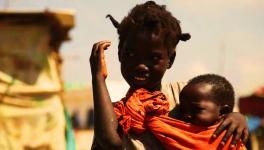COVID-19: Report Reveals Severity of Food Crisis Faced by India's Poor in 2020
On May 31, 2021, prominent economist Jean Drèze and Anmol Somanchi published a detailed report analysing the impact of the COVID-19 crisis on food security, employment, income, household expenditure and the nutrition level of people in India. The report derives its conclusions from 76 household surveys compiled by the Centre for Sustainable Employment at Azim Premji University (CSE-APU) and data from the Centre for Monitoring Indian Economy (CMIE).
The report highlights that the period between April-May 2020 has been associated with a tremendous food crisis in the country with a large proportion of the population struggling to feed their families. Food intake dipped both in qualitative and quantitative terms for the majority of the population. The crisis has resulted in a sharp decline in the consumption of nutritious food including non-vegetarian items, the report noted. While some recovery was witnessed after June 2020, employment, income and nutrition levels continued to remain below pre-lockdown levels by the end of the year.
Quoting data from a number of surveys, the report underlines a sharp decline in employment and incomes during the national lockdown between April and May 2020. According to the Dalberg survey (covering 47,000 households in 15 states), well above 80% of households were affected by income reductions during May and June and a quarter of households earned no income at all. In a three round survey held between May and September, data from the IDinsight report highlights an average income reduction of 72%, 68% and 74% respectively. The survey found that the average weekly income of non-agricultural respondents had plunged from Rs 6,858 in March 2020 to Rs 1,929 in May 2020, and remained at this level in September 2020.
“It is doubtful that income and employment ever regained their pre-lockdown levels before a second wave of the COVID-19 epidemic hit the country in early 2021,” the report goes on to add. Drastic fall in employment and incomes contributed to severe food insecurity during the national lockdown.
According to the CSE-APU survey, 77% of people were eating less food than before between April and May 2020. The second round of the survey places this estimate at 60% for the period between October and December 2020. Data collected by ActionAid revealed that in May around 35% of nearly 10,000 informal workers (mainly migrants) consumed less than two meals a day. Even in the month of June, this number came close to 20%. Similar findings were reported by other surveys from different states highlighting that decline in incomes and employment resulted in an acute food crisis amongst the poor during the national lockdown period and hardships continued through the rest of the year.
The report cites data from the periodic nation-wide household survey conducted by the CMIE. Studying the trends in per-capita income (PCI) (at constant prices) of three groups – top quartile (top 25%), middle quartile (middle 50%) and bottom quartile (bottom 25%), the report revealed that while the top quartile suffered a 25% decline in PCI during the lockdown, the bottom 25% ended up earning nothing in this period. Declining incomes resulted in about 50% drop in per capital expenditure (PCE) in each group during the national lockdown, followed by partial recovery in the later part of 2020. While expenditure decline on cereals and pulses was relatively small, the decline on nutritious food items such as fruit, eggs, fish and meat has been dramatic.
Commenting on what this decline means in terms of nutrition levels, the report adds, “even for a two-month period this is a nutritional catastrophe, bearing in mind that baseline consumption levels are very low in the first place.”
Assessing the role of Public Distribution System (PDS) during the lockdown the report notes that the PDS was a source of relief to a vast majority of population and it played a critical role in averting the worst. According to surveys, among respondents possessing a ration card, more than 80% had received some food-grains under the PDS during the reference period. Five large-scale multi-state surveys showed that the proportion of households possessing a ration card varied between 75% and 91%.
However, the report highlighted that a significant minority of ration-card holders had not received any food-grains during the reference period. Moreover, it notes that the data does not rule out the possibility that many people received less than their due by way of free grain. NFSA entitles five kg of food-grains per person per month to Priority Households and 35 kg food-grains per month to Antyodaya Households. In addition, NFSA cardholders were entitled to a monthly ration of five kg per person for free from April to November under the Pradhan Mantri Garib Kalyan Anna Yojana (PMGKAY). According to the report, a total of 30 million tonnes of wheat and rice were distributed in 2020 as additional PDS rations.
Assessing other relief measures such as cash transfers of Rs 500 under the Jan Dhan Yojana, the report emphasised that these limited and unreliable measures failed to make up for more than a small fraction of income losses induced by the national lockdown and economic crisis thereafter. CMIE data suggests that cash transfers from the Central and state government made up for less than 10% of the average income losses in April-May 2020.
The economic distress and lack of institutional support mechanism led to a surge in indebtedness and distress sale of household assets in 2020. According to the surveys conducted by Dalberg, PRADAN and ActionAid in the period between April and May the proportion of households that were forced to borrow money or defer payments during this period were 40%, 38% and 53%. The PRADAN survey revealed that about 15% of the households surveyed had to mortgage or sell their household assets in April and June.
Towards the end, the report notes that the lessons from the COVID-19 crisis appear to have been lost on the Central Government, as instead of strengthening the social security system, it has made severe cuts in financial allocations for Integrated Child Development Services (ICDS), maternity benefits and Ministry of Women and Child Development in the Union Budget 2021-22. In wake of a more severe second wave of COVID-19, the report argues that a stronger wave of relief measures is essential to avoid a repeat of last year’s tragic humanitarian crisis.
Get the latest reports & analysis with people's perspective on Protests, movements & deep analytical videos, discussions of the current affairs in your Telegram app. Subscribe to NewsClick's Telegram channel & get Real-Time updates on stories, as they get published on our website.
























